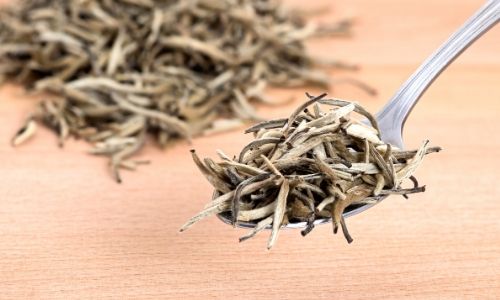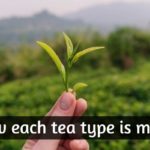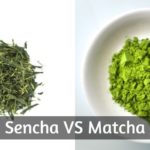Both green tea and white tea have their very special places in a tea lover's cupboard. Choosing between the two isn't easy since they both have their pros and cons.
If you're reading this comparison between green tea and white tea to figure out which tea to buy for yourself, you'll end up having a much more informed opinion than before.
So let's start with the most basic part of the comparisons - what each tea is made up of, and then go on with the rest of the differences.
Table of Contents
1. White tea is made from tips, green tea from young leaves
Both green and white tea are made from the same plant - Camellia sinensis. As such they end up having pretty much the same health benefits and roughly the same flavor profile (as opposed to Chai or rooibos, which are both made differently).
Even if green and white tea share the same plant, they come from different spots on the plant.
Believe it or not, this actually matters very much ! What do I mean ?
Well, white tea is made using the young, still unopened buds of the tea plant. The shoots with the leaves that are still tightly furled and they're really only on the topmost part of the tea plant.
This means that once picked, those shoots never get the chance to become full leaves. They end up having a more delicate flavor and are treated differently than opened leaves.
Green tea on the other hand is actually made from the same buds, but they've been allowed to open. Fully open, but not grow large. The leaves are still young, and are now producing a second bud.
Actually when leaves are picked for green tea, the perfect combination is two leaves and a bud. You' might've heard this expression at time.
Using that specific combination of leaves and buds ensures that the green tea is fresh, young, and has a bright flavor.
2. Green tea is processed differently from white tea
Not only do these two teas use different leaves, they're also processed differently.
There's already a flavor difference between them, with white tea being more delicate.
But now, with the processing of the leaves, it's going to be even more so.
Green tea leaves are set in baskets, and lightly rolled around so they can begin bruising. This is the beginning of the oxidation process, which is what's going to enhance the flavor in green tea.
Once the tea master is happy with the amount of oxidation, the leaves are left to dry out and are then lightly baked in an oven, or pan-fired so that they completely dry out.
This is the Chinese method, and the most common one. It results in dark green leaves with the slightest yellowish tinge, and the resulting brew is going to have a slightly yellow tint to it as well.
The Japanese method implies steaming the leaves instead of baking or firing, and then letting them dry out. This ensures a brighter flavor, closer to the 'raw' tea plant. And also a light green brew once the leaves are steeped.
On the other hand, the buds meant for white tea are simply left to dry out. This isn't the easiest thing to do, since the tea master has to make sure they don't burn in the sun, or don't develop mold, and that each piece is completely dried through.
This means evenly scattering the buds on bamboo sheets, and letting them dry completely. It requires a lot of space and keeping an eye out for any possible trouble, like moisture from rain or harsh winds.
Once the buds are dried, they are inspected. They should still have the very fine silver/white hairs that white tea is famous for.
Those tiny hairs are present on all tea buds, and fall off as the leaves age. But since there are shoots that never reached adulthood, they're prized for having those little hairs.
Most of the time you won't find them in your cup of tea, but if you do find them they're safe and will not hard you if ingested.
3. White tea is more delicate, and not beginner-friendly
White tea, being made from such delicate parts of the tea plant, will have a different flavor than green tea. Still a little on the vegetal side, but less pronounced.
In fact, white tea will always have a very subtle flavor, no matter how it's processed and what the tea master will try to bring forth in terms of flavor.
This isn't a flaw, but rather a warning for those who go into drinking white tea without knowing what to expect. This is not a tea for beginners, since it won't immediately hit you with this and that flavor, or a hint of something in particular.
White tea is a very refined tea, and one that takes a bit of getting used to. It's meant to be enjoyed with a clean palate, so drinking or eating anything strong flavored before white tea will overshadow the taste.
This tea is meant to be tasted and appreciated, which requires some practice and patience. Of all the high-grade Chinese teas out there, most of them are white teas.
They're revered for their subtlety of flavor and gentle notes.
Green tea is more detectable, and can easily be distinguished from any other tea.
Pure green tea isn't beginner-friendly either, but it's definitely a flavor you'll notice if you drink it plain, or with just a little sugar.
4. Green tea is astringent and might turn bitter, white tea is more subtle
As a further discussion, we should also note that green tea can become harsh in some cases like if you've brewed it too long.
It can turn bitter, and the color will go from pale yellow/green to a darker yellow, possibly light brown in some extreme cases.
This is because of the high antioxidant count naturally found in green tea leaves, and also due to how the leaves themselves were processed.
To be more specific, it has to do with the oxidation process we just discussed earlier.
Now this only happens if you brew green tea for too long, or use too much green tea to begin with and is almost unheard of if you're using teabags.
White tea, even if left to brew for too long, won't turn as bitter or harsh as green tea. It might change color, darken a little, and it might become a little bitter but the overall tone is going to be less dramatic.
5. White tea has more caffeine capacity, green tea steeps more into the coffee
As for the caffeine content, this one is always giving someone a headache.
The thing is, all tea made from the Camellia sinensis plant have roughly the same amount of caffeine. This is more of a range than an actual, definite number.
This is because caffeine content is influenced by: soil quality, how the weather was during the plant's growth, which leaves are used for the tea, and how long you steep the tea leaves.
As a result, there isn't much of a difference between tea types but there is between parts of the tea plant.
So white tea, being made from the very buds of the tea plant, are going to have the capacity to release more caffeine than any other tea. This is because buds and shoots have the most caffeine content, as they're the most vulnerable parts of the tea plant.
It sends more caffeine to its tips than to already adult leaves, in order to protect the new growth from predators and disease.
As a comparison, the leaves used for green tea are 'older' than the buds, but still much younger than the rest of the plant. So they still have a relatively high caffeine count, but will not have as much as the buds.
The catch is that white tea is very sensitive, and the buds cannot be steeped in hot water for as long as green tea leaves. This means that they're going to release much less caffeine than green tea.
Also the fact that they're tightly furled means less surface that the water touches, and less surface it's able to extract caffeine from.
So while green tea has a little less caffeine than white tea, white tea can't be brewed to release all of its caffeine and still be drinkable.
This is also why black tea wins over every other tea, since it can brew longer than green tea. This is because of how the leaves are processed for black tea, which means they can withstand up to 4 minutes of steeping.
6. Green tea comes in lots of flavors and blends, white tea is purer
If you're looking for new flavors are are willing to try white tea as a change, then you should know that white tea doesn't come in many varieties.
Most of the time white tea is a pretty simple tea, with maybe some floral notes, either added or coaxed by the tea master during the drying phase.
As for green tea, this is as versatile as black tea. You'll find green tea with literally anything, from fruits to nuts to vanilla to flower petals and coconut and ginger and anything you can imagine.
The only downside is it doesn't go with milk so some combinations are off limits, like green tea and caramel.
However you may find green tea Chai, in which green tea is the base and also contains nuts like almonds and walnut, honey, and is blended with milk.
Most of the time though, green tea come sin nearly any combination you can think of. It usually pairs well with sweeter tones.
You won't find this in white tea, however there is a version of white tea called White Peony which is meant to taste somewhat similar to peonies once brewed.
7. White tea often ends up on the more expensive side
Even though it doesn't come in many combinations, and has a specific flavor range, white tea is often expensive.
As in, twice or triple the price of regular green tea, in most tea houses. Why is this ?
It's got to do with a couple of things, and we'll go through them here.
First, white tea is expensive because it uses buds and tips from the tea plant. Meaning those tips will never become full leaves, so the tea farm is kind of sacrificing one tea for another.
Second, tips and buds aren't many, at least not as many as fresh, young leaves which are used for green tea. This means a low yield, which raises the price anyway.
Combine this with the fact that you need a lot of tea buds to make white tea, and the price rises a little more.
Third, white tea is so delicate in taste it's become a sort of status symbol, in a way. White tea is the utmost in terms of delicate, floral notes and is very much appreciated for how fragile and expensive it is. This again raises the overall price.
For example there is one version of white tea, called the Silver Needle due to the shape of the buds and the tiny silver/white hairs on the buds.
This is the most expensive white tea, and it's also the most prized of all. The tiny white hairs are a sign of good quality and are supposed to be on the buds even after drying.
By comparison, green tea is easier to come by, easier to produce, and generally comes in bigger harvests since there will always be more young leaves than tiny buds.
So which is better, green tea or white tea ?
It very much depends on your preference, and what you're looking for in a tea.
Green tea is more of an everyday tea, full of antioxidants and able to blend with most flavors. Sipping on green tea day in and day out won't really get boring if you switch up the flavors, and it comes with a whole set of health benefits.
White tea is a more refined tea, and is going to prove difficult to find at times. This isn't an everyday tea, and it might disappoint those who are unaware since it has such a delicate flavor.
If you're looking for:
- flavor, then green tea is for you
- health benefits, then green tea is the way to go but white tea is not far behind either
- a nice treat for an occasion, then white tea is the fancier one
Personally I prefer green tea, since it fits the bill nearly every time. I've had white tea at times, and it's a beautiful tea. But not something I would routinely choose over any other tea.
Conclusion
Green and white tea are two very different teas, but they share the same plant 'mother'. So you're bound to find something you like in each of them.
Hopefully this post made the differences between green tea and white tea much clearer for you, and you can comfortably choose your favorite tea now.
If you want to know more about coffee or tea, feel free to check the related articles below. Who knows what else you might find ?







